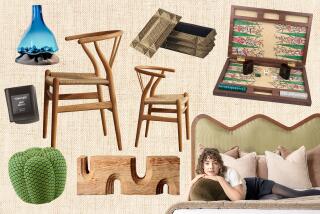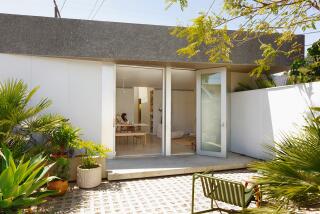Some Ways to Make Little Look Big : California Designer Demonstrates Art in English Village
LONDON â In England, as in many other countries, it is now the small affordable housing unit that is satisfying much of the desire for home ownership among lower- and middle-income singles, couples without children, and small families.
In the new community called Gloster Green in Hornchurch, which lies in the historic countryside southeast of London, Laing Homes is building a complex of living units that range from 404 to 749 square feet and sell from about $40,000 to $55,000. These include âstarterâ homes and âmove-upâ homes that have from one to three bedrooms.
By normal standards, the living space involved is very tight indeed. The initial challenge was to make it appear more spacious as well as gracious, workable, and comfortable.
Alan Thomson of Laing Homes invited an American designer-consultant, Karen Butera of Palo Alto, Calif., to design the units that would show Britons big ideas for living well in restricted spaces. He asked her to focus attention on the imaginative things that could be done in small rooms with furnishings readily available in British stores, or with built-ins.
âI had to appeal to a wide population segment,â Butera explained, âworking couples, skilled manual workers, young professionals, retired people. So I designed the show units with these real people in mind, trying to introduce a little bit of California sunshine along the way. I tried to show them how they could adapt the spaces to fit their own furnishings, needs, and circumstances.â
Following are some of the space-expanding ideas that Butera applied to the English units:
--Lighting is the major key to making small spaces appear larger. Uncovered, uncluttered windows extend sight lines and bring in an abundance of natural light. This should be supplemented with fluorescent lighting placed under valances, over kitchen and bath workspaces, and over and under kitchen cabinets. It can also illuminate and define inside dining areas and other special areas. To save space when using incandescent lamps, mount them on walls whenever possible.
--Color creates mood and a sense of spaciousness. Use no more than three blending basic colors in backgrounds, getting additional color only in accent pieces. In small spaces color must be continuous and flow completely around a room. Painting one wall in a contrasting color is not advisable. Colors such as white, oyster, beige, and muted blues and grays make pleasing backgrounds.
--Use a clear mirror to gain visual space and to reflect light. An illusion of spaciousness is created in the dining area by a wall mirror flanked by sconces. Mirroring behind the tub and on the ceiling of a bathroom increases its sense of size.
--Help make furniture âdisappearâ by mirroring the base of a dining table and by using mirrored cubes instead of bulkier coffee tables. Mirror the backsplash of kitchen cabinets. Mirror sliding closet doors. In a small kitchen with a dining table at one end, place a large square of mirror behind the table and flank it with white shutter panels.
--Give every room a focal point. It can be a piece of furniture such as a breakfront or a piano, a beautiful framed mirror, an art collection, or a âfocal wallâ of modular storage units. Latticework behind the bed can provide an unusual focal point in a small bedroom. Wallpaper used in imaginative ways can do the same. But in each case, the room should be planned around the focal point.
--Utilize every inch of space, including odd spaces. For instance, build an entertainment center under the stairwell, light it significantly, and negative space suddenly becomes a positive or plus space.
--Since scale is very critical in small spaces, the size and proportions of furnishings must always create a balance. Nothing should stop the eye. An armless sofa with a simple, tailored back is less cumbersome-looking than one with hefty arms and billowy back. The same is true of bunched modular seating: the simpler and neater the better. To open up floor space, place love seats against walls.
--Unify the space by using one uniform carpet color throughout the house, including the bathrooms, with hard-surface flooring used only in kitchens and sometimes in entranceways.
--Convert one very small bedroom into a snug computer room by building in a work counter on the three walls surrounding the single window.
--Define different and distinct living areas not with walls and room dividers, but by the subtle way you furnish, light, and handle color and texture.
More to Read
Sign up for Essential California
The most important California stories and recommendations in your inbox every morning.
You may occasionally receive promotional content from the Los Angeles Times.






